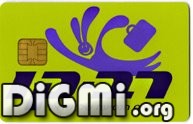Cracking “Rav-Kav” (Part I)
Yesterday at the university, I’ve got my brand new “Rav-Kav” (רב-קו) card. I was really happy when I discovered that mine was one of those “smart card with the golden chip on it”. Because I’ve got a software on my computer at home, that uses smart-card as a dongle, therefore, I’ve got a smart-card reader back at home.

My first task, was to find out how to communicate with the smart-card. A quick google search and I’ve found the wonderful python module pyscard which allows me to send and receive APDU commands to/from the smart card. My second task was to read a bit about smart cards, and the commands they use. Again, google came up handy, and I’ve found the following site which describing more-or-less every command and response you are likely to get from the little shiny card.
The first thing you need to understand, A smart-card is not a flash drive! A smart-card is a microprocessor, It has it’s own operating system, and it communicates with the device using it (my computer for example) using the T=0 protocol. Meaning: You can’t read and write whatever you want into it.
For those of you who reads this article only to get “free rides”: No, I don’t believe I’ll be able to add “free rides” to my “Rav-Kav” card, because those things are usually very protected (and even if I could, it will be illegal to use it and sharing the information), but it’s quite interesting to check what kind of information is stored in this little piece.
When I plugged the card and connected to it, the ATR was: “3B 6F 00 00 80 5A 0A 07 06 20 04 2C 02 63 EE FF 82 90 00”. But I’m not sure if that means anything….
The first thing I tried was to map all the command classes available for this card.
I’ve scanned the classes simply by trying a random command in all the possible classes (256 possibilities), and ignored all the classes that returned “0x6e – Class not supported“. I’ve found out that the only available classes are 0x80, 0x94. And that all the interesting commands shown on chapter 6 can be found on the 0x94 class.
The next thing I did was to “brute force” the file-system under the master-file using the SELECT command. And I got the following list:
0x0002 0x0003 0x2000 0x2001 0x2004 0x2010 0x2020 0x202a 0x202b 0x202c 0x202d 0x2030 0x2040 0x2050 0x2069 0x206a 0x20f0 0x2100 0x2101 0x2104 0x2110 0x2120 0x2140 0x2150 0x2169 0x21f0 0x2f10 0x3f04 0xfeff
I’m not sure yet which one of those is an EF (normal file) and which one if a DF (a directory). But I’ll find those out next time. Stay tuned.